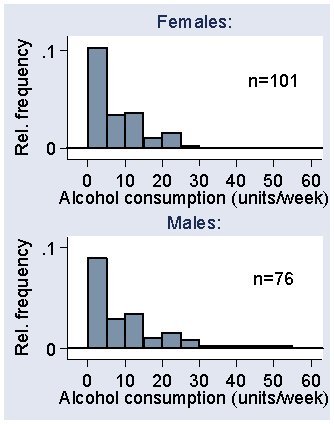 d
d
In the 2005 M.Sc. questionnaire, adult respondents were asked whether they were female or male and how much alcohol they usually consumed in a week.
The distribution of reported alcohol consumption by sex is shown in the following graph:
The data may be summarised as follows:
| Number | Mean | SD | |
|---|---|---|---|
| Female | 101 | 6.6 | 6.4 |
| Male | 76 | 9.8 | 11.0 |
The difference in mean alcohol consumption, male minus female, is 3.2 units/week. The 95% confidence interval for the difference is 0.4 to 6.0 units/week, P = 0.02.
Question 1. What kind of graph is this and what are its main features?
Question 2. What methods could be used to calculate the confidence interval for the difference in mean alcohol consumption? Which should we use here and why?
Question 3. What does ‘The 95% confidence interval is 0.4 to 6.0 units/week’ mean and what conclusion could we draw from it?
Question 4. What does ‘P=0.02’ mean and what can we conclude here?
Respondents were asked whether they ever been diagnosed as having high blood pressure. The distribution of reported alcohol consumption by reported hypertension is shown in the following graph:
The data may be summarised as follows:
| Number | Mean | SD | |
|---|---|---|---|
| Hypertensive | 21 | 8.6 | 7.8 |
| Normotensive | 157 | 7.8 | 8.9 |
The difference in mean alcohol consumption, hypertensive minus normotensive, is 1.0 units/week. The 95% confidence interval for the difference in mean is –2.7 to +4.9 units/week, P = 0.6.
Question 5. In what way are these groups more difficult to compare than are men and women?
6. If we accept the confidence interval and P value, what can we conclude about hypertension and alcohol consumption? What should we NOT conclude?
To Applied Biostatistics index.
To Martin Bland's M.Sc. index.
This page maintained by Martin Bland.
Last updated: 1 November, 2006.